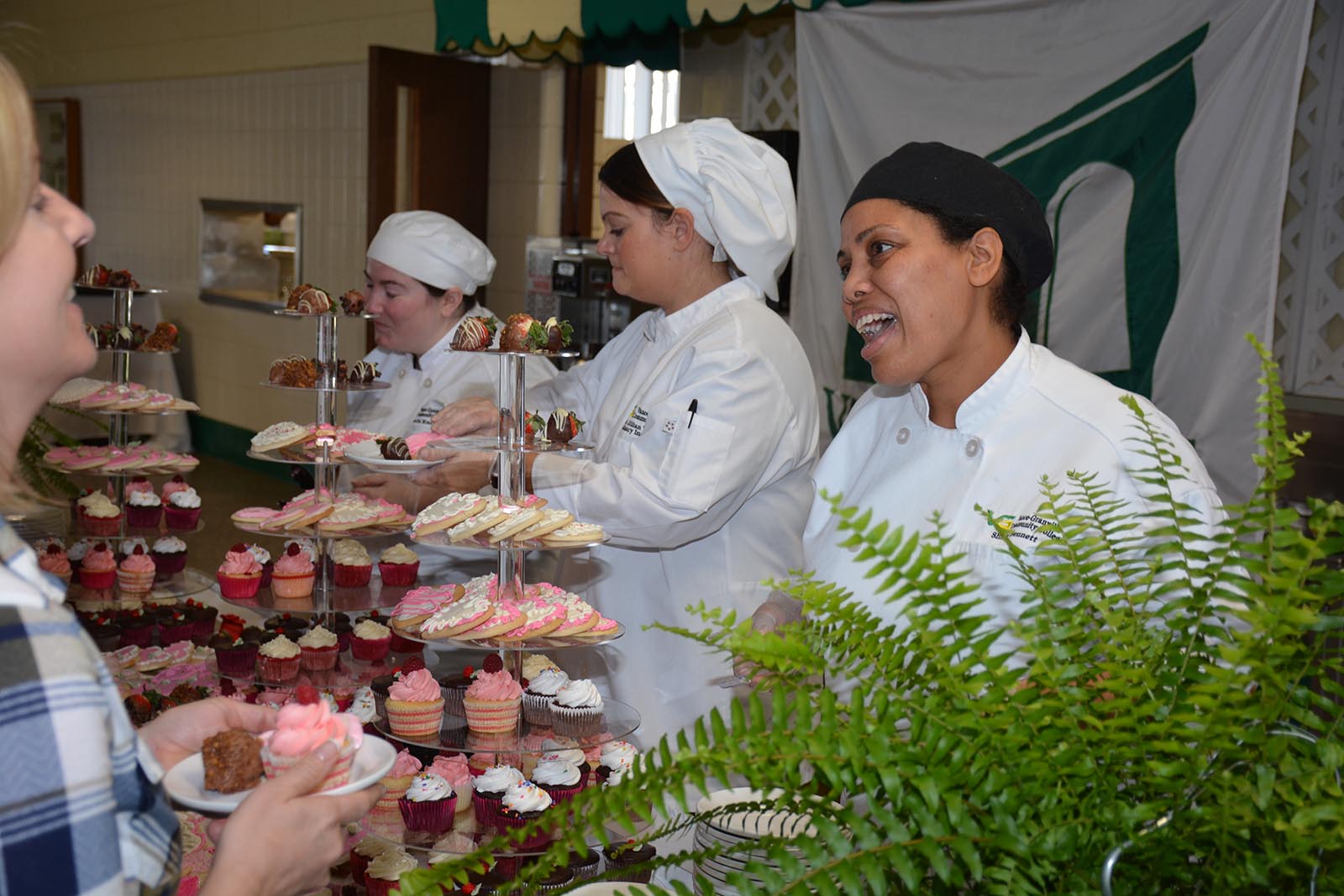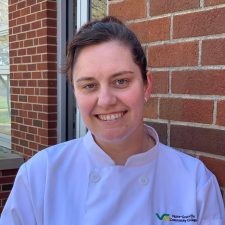This website uses cookies so that we can provide you with the best user experience possible. Cookie information is stored in your browser and performs functions such as recognising you when you return to our website and helping our team to understand which sections of the website you find most interesting and useful.
Culinary Arts
Making our world a better place through food!

Program Description
The Culinary Arts curriculum provides specific training required to prepare students to assume positions as trained culinary professionals in a variety of food service settings including full service restaurants, hotels, resorts, clubs, catering operations, contract food service, and health care facilities.
Course offerings emphasize practical application, a strong theoretical knowledge base, and professionalism and provides the critical competencies to successfully meet industry demands. Courses also include sanitation, food/beverage service and control, baking, garde manger, American/international cuisines, food production, and hospitality supervision.
Graduates should qualify for entry-level positions such as line cook, station chef, and assistant pastry chef.
American Culinary Federation certification is available to graduates. With experience, graduates may advance to positions such as sous-chef, executive chef, or food services manager.
Program Details
Discover the specifics of our programs, including required courses, course sequence, pathways, and learning outcomes.
To participate in any program in the College of Culinary Arts, each student, with or without reasonable accommodations, must be able to safely and effectively do the following.
Students with an identified disability should contact disability services in order to investigate available reasonable accommodations.
Communication
- communicate effectively and professionally when interacting with peers, faculty, staff, and guests using the English language verbally and in written form
- follow verbal and written instructions
- follow directions, describe decisions, demonstrate listening skills, write reports, and follow directions
- speak clearly and distinctly
Physical Strength and Stamina
- lift and move without assistance cookware typically found in a commercial kitchen and independently lift and move cookware containing product
- lift and move stock and supplies weighing up to 50 pounds
- stand and move about kitchen/laboratory for up to eight hours
- complete cleaning responsibilities requiring stooping, bending, and climbing
- lift and safely move pots, pans, stock pots, and small equipment
- lift and safely move pots, pans, stock pots containing hot food being prepared according to instructions
- lift and move bags and boxes of supplies weighing up to 50 pounds
- stand and move about in kitchen and dining areas during food preparation
- lift and transport trays with plated foods, china, and small wares.
- serve and clear tables where guests are seated
Mobility and Motor Skills
- move freely, quickly, and safely in a close environment
- work in coordination with other students
- move supplies between floor and standard height above head
- safely manipulate small wares, equipment, and equipment controls
- safely pour liquids, including hot liquids
- safely handle hot foods
- perform repetitive tasks required in a commercial kitchen
- move from work station to work station near other students and equipment
- lift containers (bulk and prep) individually and in coordination with other students
- lift supplies from floor, pallet, or table and place on storage racks
- remove supplies from storage racks above head at standard height
- hold containers such as pots and bowls while mixing and blending ingredients in those containers
- operate machinery and equipment safely and efficiently
- efficiently use whisking, dicing, and piping skills
Sensory
- access voice instructions in a noisy environment
- access equipment alarms
- access printed and written instructions and labels
- feel product texture
- distinguish smells and tastes
- receive instructor’s voice in a noisy kitchen/lab environment
- perceive food preparation equipment alarms
- read temperature and pressure gauges
- read ingredients labels
- taste and feel product to determine quality and doneness and adjust flavor appropriately
- read MSDS documents
Interpersonal and Emotional
- work cooperatively with other students and instructors
- complete an equitable share of kitchen duties
- follow directions of instructors and fellow students
- remain calm in a stressful environment
- display characteristics of emotional stability
- self-manage medical and emotional conditions
- participate in team projects with other students
- provide assistance to fellow students and instructors when asked
- maintain a cooperative spirit while working in a hot, crowded environment
- complete duties as assigned
- maintain a positive attitude
- manage one’s medical and emotional conditions in order to permit self, others, and the program to meet educational goals
- Students will demonstrate an understanding the importance of food safety and sanitation according to industry standards.
- Students will be competent in the use of industry standard equipment and cooking techniques.
- Students will know nutritional facts of food and special diets and how to apply their skills to a special need.
- Students will be knowledgeable in the basics of baking.
- Students will know the principals of advanced sugar and pastry development
- Students will have basic knowledge of cold food preparation techniques and pantry production.
- Students will be able to properly display and prepare cold foods.
- Students can demonstrate the proper procedure of food and beverage table service.
- Students will understand the basics of menu design and development
- Students will understand the difference of cooking principles from different regions.
- Students will understand the importance of food and beverage purchasing and receiving
- Students will be able to decipher the different job markets and choose their path in the food and beverage industry
Students enrolled in pre-approved continuing education training courses may request awarded credit in corresponding curriculum programs. They must first register, pay, and pass the continuing education course with a grade of satisfactory. In order to request awarded credit, the student must be enrolled in the corresponding curriculum program.
The credit will be awarded by the appropriate department with a grade of “PR”, Credit for Prior Learning. The credit hours of the course will count toward graduation at VGCC but may not transfer to other colleges or universities.
For a more comprehensive list of Continuing Education courses and their corresponding curriculum programs, please visit Approved CE to CU Prior Learning Credits.
Approved Prior Learning Equivalencies
| CE Course Taken | Equivalent CU Course | Credit Hours Awarded | Effective Date |
|---|---|---|---|
| CUL 3072 Food Service Sanitation/Safety, 3.4 CEUs | CUL 110 Sanitation and Safety | 3 | October 20, 2020 |

“I have had an amazing time in this program! Made some friends, learned so much, and had some great experiences.”

